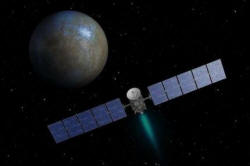|
 U.S.
science probe nears unexplored dwarf planet Ceres U.S.
science probe nears unexplored dwarf planet Ceres
 Send a link to a friend
Send a link to a friend
[March 03, 2015]
By Irene Klotz
CAPE CANAVERAL, Fla. (Reuters) - A NASA
science satellite on Friday will wrap up a 7-1/2-year journey to Ceres,
an unexplored dwarf planet in the main asteroid belt between Mars and
Jupiter, scientists said on Monday.
|
|
 The Dawn spacecraft visited the asteroid Vesta before firing its
electric ion engine to continue on to Ceres, a round, 600-mile-wide
(970 km-wide) mini-planet that is the largest body in the asteroid
belt. The Dawn spacecraft visited the asteroid Vesta before firing its
electric ion engine to continue on to Ceres, a round, 600-mile-wide
(970 km-wide) mini-planet that is the largest body in the asteroid
belt.
Earth’s moon, by comparison, is about 2,160 miles (3,480 km) in
diameter.
The solar-powered probe is expected to put itself into orbit around
Ceres at 7:20 a.m. EST (1220 GMT) on Friday. However, radio
telescopes on Earth will not be in position to pick up Dawn’s signal
until later in the day, National Aeronautics and Space
Administration officials said at a news conference.
“The approach has gone flawlessly so far,” said Dawn Project Manager
Robert Mase of NASA’s Jet Propulsion Laboratory in Pasadena,
California.

Scientists are eager for their first close-up look at a dwarf
planet, believed to be a building block left over from the formation
of the planets 4.6 billion years ago. “They’re literally fossils
that we can investigate to understand the processes that were going
on at that time," said Dawn scientist Carol Raymond, also with Jet
Propulsion Laboratory.
Another NASA spacecraft, New Horizons, will fly by the distant dwarf
planet Pluto in July. Pluto, once considered one of the planets of
the solar system, was later downgraded to a dwarf planet.
Ceres, namesake of the Roman goddess of agriculture, is already
providing intrigue. Pictures relayed from Dawn last month show
bright streaks on its surface, including two very bright spots
inside a crater. “These spots were extremely surprising,” Raymond
said. Scientists suspect Ceres may have had an underground ocean
early in its history that later froze. Impacting asteroids or comets
could then have exposed patches of highly reflective ice.
[to top of second column] |

Europe’s Herschel space-based telescope previously detected water
vapor on Ceres, a clue that impacting bodies may periodically send
plumes of watery material shooting into space. “In the initial views
of Ceres, we see many strange features: smooth areas, areas that
chaotically fractured and craters of all shapes and sizes,” Raymond
said. “Of particular interest are the bright spots ... which stand
out against Ceres' dark surface.”
It will take Dawn about a month to position itself for 14 months of
observations of Ceres. In all, the mission is costing NASA $473
million.
(irene.klotz@thomsonreuters.com)
[© 2015 Thomson Reuters. All rights
reserved.]
Copyright 2015 Reuters. All rights reserved. This material may not be published,
broadcast, rewritten or redistributed.
 |